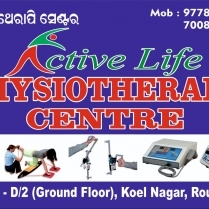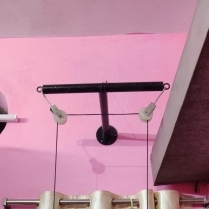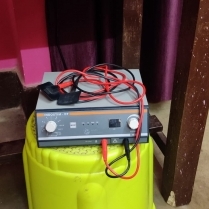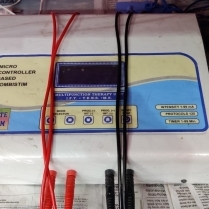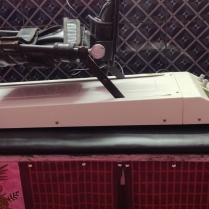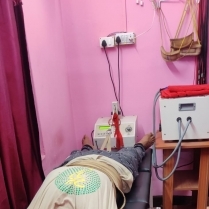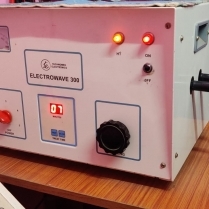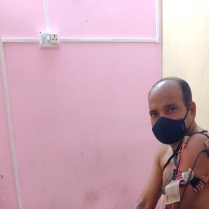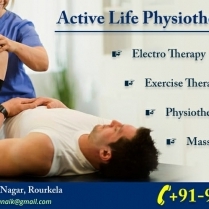ACTIVE LIFE PHYSIOTHERAPY CENTRE
place D/2 , GROUND FLOOR, KOELNAGAR, ROURKELA,769014
person Dr. Debashish Pattanaik
mail_outline[email protected]
Image Gallery
Business Information
Home/About us
Dr.DebashishPattanaik is the driving force behind the launching of ACTIVE LIFE PHYSIOTHERAPY CENTREcarrying a motto of“Value for painless life”. He has nearly a decade of experience in the field of Physiotherapy and has handled several complicated cases single handedly, which made him expertise in analysis and treatment of various physical disabilities. ACTIVE LIFE PHYSIOTHERAPY takes all kind of personal and professional care of patients and provides the best physiotherapy and fitness services. We also provide home visits to completely incapacitated patients for both physical and equipment exercises.
Dr. DebashishPattanaik is the Life member of Indian Association of Physiotherapists. He is also associated with UHMC, Rourkelaas a senior physiotherapist and has gigantic experience to offer his patients a medically sound, safe and effective exercises aiming to treat the cause of pain and not the symptoms. Situated at D-2, Koelnagar (just a 15 min. ride from Rourkela railway station) Active Life Physiotherapy Centre is one of the leading organizations in physiotherapy field which provides a vast range of treatments available in this field with optimum affordable prices and best possible care.
SERVICES
Functionality and/or mobility using exercise equipment that is specifically designed to meet needs of patients with acute or chronic health conditions such as, arthritis, Spondylitis, Parkinson’s disease, physical disabilities or other problems or through individualized exercise routines that improve or restores physical function so that activities of daily living are no longer a challenge, reduce risk factors and improve overall health and fitness.
Physiotherapeutic modalities available at Active Life Physiotherapy Clinic include:
- Mechanical Traction (Lumbar and Cervical)
- Interferential Therapy (IFT)
- Muscle Stimulation
- Trans Cutaneous Electrical Nerve Stimulation (TENS)
- Continuous Passive Motion (CPM)
- Short wave Diathermy (SWD)
- Infra-Red Therapy
- Shoulder wheel Exerciser
- Rope pulley Exerciser
- Ultrasound Therapy
- Finger griping Exerciser
- Hydro collator Therapy
- Paraffin Wax bath
- Physio Ball exercise
- Message Therapy
- Physical Exercises such as: stretching exercise, Resistance exercise, Strengthening exercise, Mobilization technique, manipulation technique etc…
ACTIVE LIFE PHYSIOTHERAPY CENTRE provides specialized consultation for: Cervical and lumbar spondylitis, Paralysis, Fracture, Osteoarthritis, Orthopedics problems, Neurological Problems, Cerebral Palsy and Sports injury etc…
&
Provides best of class treatment for: Back pain, Knee Pain, Arthritis, Frozen Shoulder, Sciatica, ERB’s Palsy, Facial Palsy, Tennis Elbow, Ligament injury, Autism and the list goes on.
We also keep on updating us with new equipment and treatment methods to provide our patients an excellent quality of services.
We wish all our visitors a speedy recovery and a pleasant treatment experience with us.
Treatments available at
“ACTIVE LIFE PHYSIOTHERPAY CENTRE”.
- Mechanical Traction (Lumbar and Cervical)
Lumbar Traction:
Various forms of lumbar traction have been used for the relief of pain since the time of Hippocrates. During the 1950’s and 1960’s it became popular, and until today it is used by physiotherapists for treating patients with low back pain and leg pain.
There are three benefits described of lumbar traction: distraction to increase the intervertebral space, tensing of the posterior longitudinal vertebral ligament and suction to draw the disc protrusion towards the center of the joint.
In mechanical traction: using a mechanical device and a specially designed table that is divided into two sections. The device delivers a certain tension to perform the traction. The patient wears a harness, which consists of two rings, to support the patient.
Cervical Traction:
Cervical traction is a treatment often used in physical therapy to help treat neck pain and cervical radiculopathy. Symptoms that often come from neck include pain in the middle of the neck, pain in one side of the neck, or pain in one or both of shoulder blades. Occasionally, symptoms coming from the neck may be felt as pain or numbness and tingling in the arm or hand.
Mechanical traction for the neck involves using a harness that attaches to the head and neck while patient lies down on its back. The harness is attached to a machine that can provide a traction force, and the machine has a control panel so that the physical therapist can change the amount of force applied to neck.
- Interferential Therapy (IFT)
The basic principle of Interferential Therapy (IFT) is to utilize the significant physiological effects of low frequency electrical stimulation of nerves without the associated painful and somewhat unpleasant side effects sometimes associated with low frequency stimulation. Interferential Therapy (IFT / IFC) has been widely used in therapy for many years.
Interferential therapy utilizes two of the medium frequency currents, passed through the tissues simultaneously, where they are set up so that their paths cross & they literally interfere with each other – hence another term that has been used in the past but appears to be out of favor at the moment – Interference Current Therapy. This interaction gives rise to an interference current (or beat frequency) which has the characteristics of low frequency stimulation – in effect the interference mimics a low frequency stimulation.
- Muscle Stimulation
Muscle Stimulation is the elicitation of muscle contraction using electric impulses. EMS has received an increasing amount of attention in the last few years for many reasons: it can be utilized as a strength training tool for healthy subjects and athletes; it could be used as a rehabilitation and preventive tool for partially or totally immobilized patients.it could be utilized as a testing tool for evaluating the neural and/or muscular function in vivo; it could be used as a post-exercise recovery tool for athletes.
In medicine, EMS is used for rehabilitation purposes, for instance in physical therapy in the prevention of disuse muscle atrophy which can occur for example after musculoskeletal injuries, such as damage to bones, joints, muscles, ligaments and tendons. This is distinct from transcutaneous electrical nerve stimulation (TENS), in which an electric current is used for pain therapy.
In EMS training few muscular groups are targeted at the same time, for specific training goals.
- Trans Cutaneous Electrical Nerve Stimulation (TENS)
This is the use of electric current produced by a device to stimulate the nerves for therapeutic purposes. TENS, by definition, covers the complete range of transcutaneous applied currents used for nerve excitation although the term is often used with a more restrictive intent, namely to describe the kind of pulses produced by portable stimulators used to treat pain.The unit is usually connected to the skin using two or more electrodes. A typical battery-operated TENS unit is able to modulate pulse width, frequency and intensity. Generally TENS is applied at high frequency (>50 Hz) with an intensity below motor contraction (sensory intensity) or low frequency (<10 Hz) with an intensity that produces motor contraction.
- Continuous Passive Motion (CPM)
Continuous passive motion (CPM) devices are used during the first phase of rehabilitation following a soft tissue surgical procedure or trauma. The goals of phase 1 rehabilitation are: control post-operative pain, reduce inflammation, provide passive motion in a specific plane of movement, and protect the healing repair or tissue. CPM is carried out by a CPM device, which constantly moves the joint through a controlled range of motion; the exact range is dependent upon the joint, but in most cases the range of motion is increased over time.
CPM is used following various types of reconstructive joint surgery such as knee replacement and ACL reconstruction.
For people who have had total knee replacement without complications, continuous passive motion has been shown to provide clinically relevant benefits. CPM does improve long-term function, long-term knee flexion and knee extension in the short or long term. In unusual cases where the person has problems which prevent standard mobilization treatment, then CPM may be useful.
- Short wave Diathermy (SWD)
Diathermy is a therapeutic modality that is most commonly used for joint conditions such as rheumatoid arthritis and osteoarthritis and cervical / lumbar spondylitis. The term diathermy refers to the creation of heat using electrical pulses. In diathermy, a high-frequency electric current is delivered via shortwave, microwave, or ultrasound which is able to generate deep heat in body tissues. The heat can be used to improve circulation and/or to relieve pain. In addition, shortwave diathermy can be used in medicine for treating damaged tissues and relaxing muscles.
The electric pulse of Short-Wave Diathermy creates heat deep inside a targeted tissue, reaching areas as deep as two inches from the skin’s surface. While the diathermy machine doesn’t apply heat directly to the body, the current created by the machine allows the body to generate heat within the targeted area itself.
It is when the heat of the area increases, that blood flow is improved along with improvements to flexibility in stiff joints and connective tissue making it a good choice to use for patients with arthritis.
The main benefits for decreased pain and inflammation are it allows patients to gently increase their range of motion allowing them to move with more ease and participate in rehabilitation with more comfort.
- Infra-Red Therapy
Infra-red rays are electromagnetic waves, the heat energy obtained from the rays are used to relieve pain. This is an invisible electro-magnetic radiation of the wavelength range of 750 nm–100 μm and its sources are heated bodies. Recently, the infra-red radiation has become popular and relatively safe method of treatment which is used in many diseases of the locomotors system.Furthermore, it isdescribed that IR influences favorably pain perception (due to increase of endorphin secretion)immunological reactions, acceleration of metabolism and also regulation of activity of autonomic nervous system in the aspect of controlling muscle tension.
The most common generators of IR, which are used widespread in physiotherapy, are Sollux lamps. They belong to the light generators in which the source ofradiation is light bulb. Non-light generators are Helios and Emit with filament IR source which is heated to the high temperature.
- Shoulder wheel Exerciser
Shoulder pain is an extremely common complaint among the general population, representing the fourth most frequent musculoskeletal problem reported by sufferers. This can be caused from several reasons and shall impact one’s day to day activities. This can cause severe pain if neglected for long time. Rehabilitation is the key to returning the shoulder to its original state, which is typically accomplished through simple exercises. The Shoulder Wheel is just such a mechanism.It allows patients to perform resistance exercises to improve range of motion and relieve pain.
- Rope pulley Exerciser
Rope pulley exerciser improves range of motion and coordination for those suffering with arthritis, shoulder or arm injuries, or post-surgery stiffness. They can also help with strengthening the arms, shoulders and chest. Pulley exercisers can be mounted over a door, on the floor, or attach to a wall.
The Wall Mounted Overhead Pulley is ideal for those with weak upper body strength and receiving rehabilitation for it. It is a light duty wall mounted exercise in which there are no extra weights applied.
- Ultrasound Therapy
Therapeutic ultrasound is a modality that has been used by physiotherapists since the 1940s. Ultrasound is applied using the head of an ultrasound probe that is placed in direct contact with the skin via a transmission coupling gel.
Therapeutic ultrasound has been shown to cause increases in healing rates, tissue relaxation, tissue heating, local blood flowand scar tissue breakdown.
The effect of ultrasound via an increase in local blood flow can be used to help reduce local swelling and chronic inflammation, and, according to some studies, promote bone fracture healing. The most common conditions treated with ultrasound include soft tissue injuries such as tendonitis, non-acute joint swelling and muscle spasm. Most muscle and ligament injuries can benefit from therapeutic ultrasound.
- Hydro collator Therapy
A hydro collator is a stationary or mobile stainless-steel thermostatically controlled liquid heating device designed to heat hydro collator packs in water up to 160 degrees where the packs will be removed and wrapped in several layers of toweling and applied to the affected body area of a patient to relieve acute pain.
Hydro collator packs are essentially just therapeutic pads that can be heated or iced in order to treat a wide range of conditions on an exterior level. Most often, these packs provide a unique type of moist heat to a patient, which tends to be more effective for treating pain related conditions than traditional electrical heating pads are. This is because moist heat is able to relax the muscles and nerves without drawing up moisture from the skin, so the affected area remains hydrated, which is important for a quicker healing process. Furthermore, these pads can be filled with different substances with different effects and benefits.
- Paraffin Wax bath
The warm paraffin also moisturizes for healthier looking, softer skin. Therabath warm paraffin wax treatments are fast-acting, drug-free, and versatile heat therapy for many different applications from arthritis joint pain relief to salon hand, foot, and facial services. A paraffin treatment uses warm oil-based wax to provide pain relief to hands, feet and sore joints and muscles. Paraffin Baths are ideal for physical therapy in arms, hands and feet, providing relief to joints, reducing inflammation and treating muscular pain. Paraffin baths provide a protected and regulated application of heated temperature to affected area.
- Physio Ball exercise
A physio ball is a ball constructed of soft elastic with a diameter of approximately 35 to 85 centimetersand filled with air. The air pressure is changed by removing a valve stem and either filling with air or letting the ball deflate. A primary benefit of exercising with a physio ball as opposed to exercising directly on a hard flat surface is that the body responds to the instability of the ball to remain balanced, engaging many more muscles. Those muscles become stronger over time to keep balance. Most frequently, the core body muscles: the abdominal muscles and back muscles are the focus of physio ball fitness programs.
- Message Therapy
Massage therapy is manual manipulation of soft body tissues (muscle, connective tissue, tendons and ligaments) to enhance a person's health and well-being.People use massage for a variety of health-related purposes, including to relieve pain, rehabilitate sports injuries, reduce stress, increase relaxation, address anxiety and depression, and aid general wellness. In general, therapists press, rub, and otherwise manipulate the muscles and other soft tissues of the body. They most often use their hands and fingers, but may use their forearms, elbows, or feet.

Visitors : 4182187
Website
IMPORTANT LINKS
Copyrights © 2024 PMC YELLOW PAGES.
All Rights Reserved.



